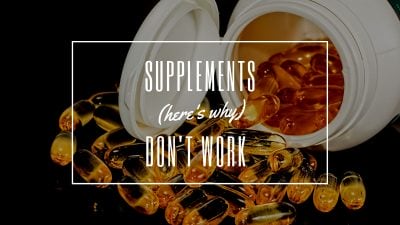49. That’s how many pills, capsules, and tablets I took on a daily basis.
Add powders to that, and I was in the supplement popping top one percent.

Other biohackers do the same. It’s hard to say no to promising new compounds. The issue is that most dietary supplements don’t work the way you expect them to.
Isolating just a few ingredients into a high-dose supplement is like selling a single guitar string. It sounds okay and may have an effect. But it lacks the richness and powerful synergy of the full sound spectrum. Click To TweetI completely stopped taking most in the last few years, for good reason. Not only have I found supplementation less effective and a waste of money, but in certain cases downright dangerous. This article exposes some of the problems with dietary supplements, and why I’d sooner stop supplementation than choose an average manufacturer.
A Boatload of Fillers, Binders, Inactive Ingredients
My astaxanthin supplement provided a 12 milligram dose.
The problem? The manufacturer put them in a capsule designed to hold 400mg. I know from comparing capsule sizes to my other supplements.
400mg – 12mg = 388 milligrams of filler.
Some highly rated supplements contain as much as 97 percent filler.
That’s a lot of quantity, but how about quality of the filler?
Don’t let the name fool you, magnesium stearate isn’t a useful form of magnesium. It’s used to prevent powders from sticking to machinery. And is implicated in health conditions. Other common ingredients include:
- Titanium dioxide
- Talc
- Starch
- Gluten
Yes, some manufacturers add gluten to their products. There’s no biological need for these additives. One day I did a calculation:
388mg of filler per pill x 49 pills = 19,012 milligrams, or I consumed ~19 grams of unnecessary supplement filler per day.
For context, I use 20 grams of coffee beans to make my coffee.
Mega-Dosing Phytochemicals
Plants can’t move. So they produce chemical defense molecules.
The more environmental stress, the more they produce. Organic plants experience more stress, and therefore produce higher concentrations of these hormetic adaptation-boosting compounds.
They’re meant to protect the plants. To poison predators foolish enough to eat them.
Humans evolved to handle them in normal levels (found in organic plants).
Resveratrol and sulforophane, two examples of them, get a lot of attention. You’ll do fine with the amount you get in wine or broccoli respectively.
If “the dose makes the poison”, why concentrate dosages to far exceed anything humans encounter naturally?
Vanity Biometrics
Vitamin D pills don’t replace sunlight. Not even close.
Your body actually produces vitamin D in response to sunlight. Only sunlight can sulfate vitamin D into its active form. Vitamin D without sunlight doesn’t do much.
Unlike supplementation, excess vitamin D from sunlight gets converted into the inactive form of 24,25(OH)2-D3. Natural sunlight in reasonable “doses” does not become toxic like the supplemental form can.
Sunlight alone has plenty of other roles:
- Stimulates mTOR
- Causes systemic nitric oxide production
- Creates endorphins
- Upregulates melanocyte stimulating hormone (MSH), increasing sex drive, libido, beta-endorphins, substance p
- Produces calcitonin, a gene-related peptide
Without vitamin K, vitamin D can lead to calcification of the arteries.
Vitamin D is just one example where a pill does not replace the natural (free) source.
Missing Other Compounds
Every day we discover new bioactive compounds in old foods.
I’m talking really old. Thousands of years old.
Until recently, scientists reviewed turmeric as a delivery mechanism for curcumin, its primary active ingredients.
Then they discovered other compounds in turmeric. Like turmerosaccharides.
Every time you take an extract you miss great ingredients that science has yet to recognize, test, and label. And any potential synergies they have with other naturally present compounds.
Synergy
Some things work better together.
That’s why nature packages them together.
Our ancestors seem to have known as well. Ancient preparations and recipes take advantage of synergies to get more from their food.
Ayurveda advocates heavy use of turmeric and ghee. You can improve bioavailability by altering liver enzymes with experimental extracts, or you can drizzle some fat onto your turmeric-coated food.
Drawing on the phytochemical example, sulforaphane in broccoli only activates when glucoraphanin comes into contact with an enzyme called myrosinase. You cannot get too much from plants, but can from supplements.
There’s countless other examples of plants producing synergistic compounds. Extracts forego synergies.
Mystery in a Bottle
Supplement labels provide dosing information, but not always accurately.
Sites like Labdoor.com regularly review products. They uncover discrepancies in dosing, sometimes quite large.
Certain supplements might not be what they appear.
For example, I read about reservatrol in David Sinclair’s book Lifespan. I did my research and considered trying them. I wondered about the price disparity between big brand names and the cheaper generic brands. Their labels looked the same.
After extensive research, I uncovered that cheap brands create their products by extracting resveratrol from peanut skins rather than grapes. Inflammatory peanut skins surely offset the pros of resveratrol.
You could end up with overpriced sugar pills, or worse.
A Huge Red Flag For Supplement Lovers
Supplement manufacturers get away with shady practices.
Unlike foods and pharmaceuticals, there’s a serious lack of (mandatory) regulation and quality control for supplements.
New reports come out all the time showing:
- Heavy metal toxicity
- Undisclosed ingredients
- Contamination with mold
- Adulttration with hormones and banned substances
When profit proceeds safety, you’re headed for trouble.
It’s more important than ever to choose a reputable supplement brand.
Declared Useless By Manufacturer
I buy supplements in bulk.
If it’s something I’ll use, I probably will use it often.
Like their whole foods counterparts, supplements expire. Some faster than others. And sometimes significantly before the date on the label.
Depending on where you buy them, they can expire before they reach you.
Trustworthy brands put their products through thorough stability testing. Testing ingredients and the final product for potency towards the end of the expiration window.
I’ve had this happen on a few supplement orders from Amazon. What happens when a supplement expires? Hopefully nothing. Maybe contamination. Who knows.
Pixie Dusting
“Pixie dusting” should be called lying.
It’s the process of including just enough of a certain compound to get it on the label, without the cost of an effective dose.
Some big name products include such a low dose of the supposed ingredients, that it hardly qualifies as supplementation. And most supplement companies do not undergo rigorous third-party testing.
For example, in this FTC complaint, a multi-billion dollar manufacturer was caught dosing products at one-thousandth of the effective dose. That means to get the purported benefits, unwary consumers would need to consume one thousand doses every day.
As the above complaint shows, even children’s supplements are not safe from pixie dusting.
Standardized Plant Anatomy
Seeing specific active ingredients (and their quantities) on labels isn’t enough.
Next up, you must check which part of the plant the supplement uses.
Depending on the plant, maximum potency comes from either root, flower, or leaf.
Different parts of the plant can vary dramatically in price.
Some less-than-ethical manufacturers will use sub-optimal forms of the plant to save a buck. To the unsuspecting, the label shows a healthy dose of active ingredients, so what could be wrong?
Always make sure that supplements are standardized to the researched plant part (root, flower, or leaf) and known active ingredients.
How to Supplement Smart: Choose Natural Whole-Food Formulas
I cut back my collection, but I still supplement on a daily basis.
Get most of your nutrients from real foods. Then, fill any gaps with minimally processed supplements. Whole plant formulations from reputable sources generally beat synthetic isolates. Click To TweetI see too much downside in potential pharmacological interaction from taking dozens of extracts on a daily basis.
In a pinch, they help.
As their name suggests, I use them to supplement a nutritionally rich diet (see my supplement stack, and the supplement brands I trust).
Remember, the more you take, the harder it is to isolate the effects of other lifestyle change.



